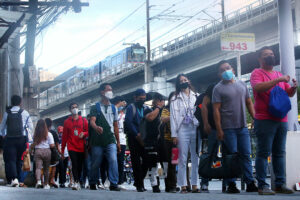THE SUPPLY of public transport is deteriorating as operators see their margins eroded by high fuel prices, an advocacy group said, making it a matter of urgency for the government to prepare measures that will encourage “active transport,” including the construction of bicycle lanes and walking corridors.
In a statement, the Move As One transport coalition said that with the “rising transport demand outpacing collapsing supply,” policymakers and the incoming economic team must decisively expand the number of public utility vehicles (PUVs), while heavily investing in infrastructure that would encourage more people to walk or cycle.
“The transport sector is in a deadly spiral: Oil prices are skyrocketing. Drivers are losing their jobs as they cannot afford to ply their routes,” the group said. “Public transport supply is collapsing. More commuters are experiencing long lines, waiting times, and crowded commutes in enclosed spaces, and are at-risk for COVID-19.”
Transport was the second biggest driver of overall inflation in May, according to the Philippine Statistics Authority (PSA). The 14.6% inflation in transport costs recorded in May outstripped the overall inflation rate of 5.4%.
“Economic managers should prioritize walking, cycling, and road-based public transport,” the group said. “This is the most important policy shift economic managers should take. It is the founding principle of the fight against transport inflation and the fastest, most effective, and the only sustainable way to do so.”
The coalition said walking, cycling, and road-based public transport are the “predominant ways people travel to get to work.”
Citing a Social Weather Stations (SWS) survey conducted in 2020, the group said 44% of workers walked to work, compared to only 3% who use private cars and 24% who use motorcycles.
The group said 14% of workers used tricycles, 8% jeepneys, 3% buses, 0.2% trains and 0.1% airplanes. Only 0.4% used ride sharing platforms, it added.
Move As One said that from 2010 to 2021, the National Government budgeted 1% or P40 billion to improve walking, cycling, and road-based public transport, compared to P2.8 trillion for road construction, widening, and maintenance, benefitting mainly private motor vehicles.
“If the national budget is the real measure of the government’s priorities, then the National Government has given only 1% of its attention to the majority of Filipinos who depend on and demand better public transport,” it said.
“Safe pathways, accessible walkways, protected bike lanes, and bus rapid transits are much easier, cheaper, and faster to build than these big ticket infrastructure projects, and will have a much greater and more immediate impact on commuters’ lives and transport prices,” it added.
The investment gap for such modes of transport was estimated at P150 billion over the next budget cycle, it said. “This is a much smaller, but more effective use of our taxpayer money than the P2.8-trillion road construction budget in the past decade, and the P2-trillion transport infrastructure pipeline in the next decade.”
Move As One also urged economic managers to encourage local governments to apply for the P10.6-billion support fund that would allow them to install more protected bike lanes, pedestrian infrastructure, open spaces, and public parks.
Under a program which expires on June 30, villages, municipalities, cities, and provinces can get up to P5 million, P10 million, P20 million, and P30 million, respectively.
Move As One also asked the Department of Transportation to immediately implement and spend the P2-billion active transport budget for protected bike lanes, wider and safer pedestrian walkways, and at-grade crosswalks for persons with disabilities. “As of today, this budget has not been used.”
The number of trips not served by public transport was estimated at around 2.8 million a day in Metro Manila before the pandemic, the coalition said.
The number of bus and jeepney trips declined 14% between 2012 and 2019 on Metro Manila’s major roads as private car and motorcycle trips surged 46%, worsening road congestion, Move As One said, citing government data.
“Despite the steady growth in our urban populations, there has been hardly any increase in the supply of public transportation in Philippine cities over the past decade,” it said. “The oil crisis has only worsened this shortage of public utility vehicles — and the suffering of countless commuters competing for scarce public utility vehicles.”
Move As One also urged the government to implement an enhanced service contracting program and accelerate the release of payments to workers who have been contracted by the government.
The government must increase the capacity of PUVs, in part by allowing them to use special lanes and setting aside hours for their operations, it added.
“The government can implement these PUV-only lanes today because the Department of Transportation has a special provision under the 2022 budget which requires 50% of road space to be allocated for walking, cycling, and public transport.” — Kyle Aristophere T. Atienza
